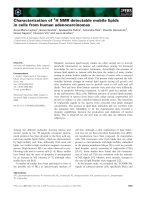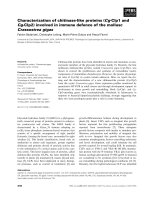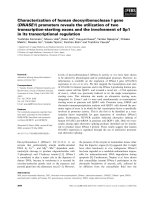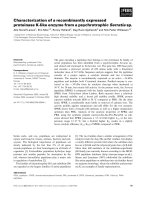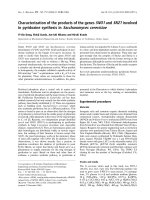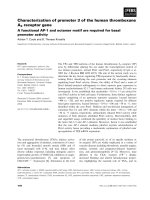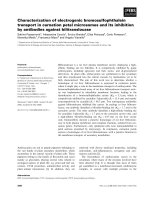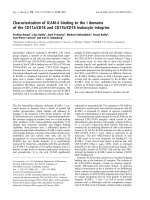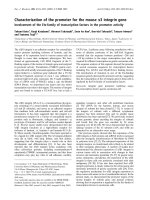Báo cáo khoa học: Characterization of Trypanosoma brucei PEX14 and its role in the import of glycosomal matrix proteins pptx
Bạn đang xem bản rút gọn của tài liệu. Xem và tải ngay bản đầy đủ của tài liệu tại đây (241.56 KB, 9 trang )
Characterization of
Trypanosoma brucei
PEX14 and its role
in the import of glycosomal matrix proteins
Juliette Moyersoen
1,
*, Jungwoo Choe
2,
*, Abhinav Kumar
3,
†, Frank G. J. Voncken
4
, Wim G. J. Hol
2,3
and Paul A. M. Michels
1
1
Research Unit for Tropical Diseases, Christian de Duve Institute of Cellular Pathology and Laboratory of Biochemistry,
Universite
´
Catholique de Louvain, Brussels, Belgium;
2
Department of Biochemistry, University of Washington, Seattle, USA;
3
Biomolecular Structure Center, Howard Hughes Medical Institute, University of Washington, Seattle, USA;
4
Zentrum fu
¨
r Molekulare Biologie der Universita
¨
t Heidelberg, Germany
It has been shown previously in various organisms that the
peroxin PEX14 is a component of a docking complex at the
peroxisomal membrane, where it is involved in the import of
matrix proteins into the organelle after their synthesis in the
cytosol and recognition by a receptor. Here we present a
characterization of the Trypanosoma brucei homologue of
PEX14. It is shown that the protein is associated with gly-
cosomes, the peroxisome-like organelles of trypanosomatids
in which most glycolytic enzymes are compartmentalized.
The N-terminal part of the protein binds specifically to
TbPEX5, the cytosolic receptor for glycosomal matrix
proteins with a peroxisome-targeting signal type 1 (PTS-1).
TbPEX14 mRNA depletion by RNA interference results, in
both bloodstream-form and procyclic, insect-stage T. brucei,
in mislocalization of glycosomal proteins to the cytosol. The
mislocalization was observed for different classes of matrix
proteins: proteins with a C-terminal PTS-1, a N-terminal
PTS-2 and a polypeptide internal I-PTS. The RNA inter-
ference experiments also showed that TbPEX14 is essential
for the survival of bloodstream-form and procyclic trypano-
somes. These data indicate the protein’s great potential as
a target for selective trypanocidal drugs.
Keywords: trypanosome; glycosome biogenesis; PEX14;
protein–protein interactions; RNA interference.
All protists grouped in the order Kinetoplastida have a
unique form of metabolic compartmentation: the majority of
the glycolytic enzymes is present in organelles called glyco-
somes [1,2]. This compartmentation has been studied in
detail in the kinetoplastid Trypanosoma brucei, the causative
agent of African sleeping sickness. When present in the
mammalian bloodstream, this parasite is totally dependent
on glycolysis for its ATP supply as it lacks a functional
Krebs’ cycle and the mitochondrial system for oxidative
phosphorylation. In contrast, the procyclic trypomastigote
living in the midgut of the tsetse fly relies more on
mitochondrial activity. Because of its importance for the
mammalian infective stage, glycolysis has been indicated as a
validated target for the design of drugs against these
parasites. The unique manner in which the pathway is
organized in these organisms, and the observation that the
structure and kinetic properties of most of their glycolytic
enzymes display many special features, may allow the
development of trypanocidal drugs that act through blocking
specifically glycolysis in the parasites without interfering with
the metabolism of the host [3].
The glycosome is an organelle related to peroxisomes
[2,4,5]. Peroxisomes are compartments of eukaryotic cells
that may harbour different enzymatic systems in organisms
belonging to distinct taxonomic groups, but all peroxisomes
have in common a number of metabolic functions such as
an involvement in the metabolism of peroxides, fatty acids
and ether lipids [6]. These functions are also shared by
kinetoplastid glycosomes, which however, have glycolysis as
their most distinctive feature. Considerable evidence is
available to indicate that the presence of intact glycosomes
and the proper targeting of glycolytic enzymes to the
organelles is essential for kinetoplastid parasites [7–10].
Therefore glycosome biogenesis may also be a good target
for drug interference.
At least 23 proteins, called peroxins (PEX), have been
identified in yeasts and mammalian cells as factors involved
in the biogenesis of peroxisomes (reviewed in [11–14]).
Peroxisomal matrix proteins are synthesized on free ribo-
somes in the cytosol, and are translocated across the
peroxisomal membrane usually without any form of pro-
cessing. The proteins to be imported are recognized by a
cytosolic receptor, either PEX5 or PEX7, depending on their
peroxisome-targeting signal, PTS-1 or PTS-2, respectively.
PTS-1 is a C-terminal tripeptide -SKL or a variation thereof.
Correspondence to P. A. M. Michels, ICP-TROP 74.39,
Avenue Hippocrate 74, B-1200 Brussels, Belgium.
Fax: + 32 27626853, Tel.: + 32 27647473,
E-mail:
Abbreviations: ALD, aldolase; GAPDH, glyceraldehyde-3-phosphate
dehydrogenase; PEX, peroxin; PTS, peroxisome-targeting signal;
PYK, pyruvate kinase; RNAi, RNA interference; Tet, tetracycline;
TIM, triosephosphate isomerase.
*Note: These authors contributed equally to this study.
Present address: Plexxikon, Berkeley, California, USA.
Note: The novel nucleotide sequence data published here have been
deposited in the EMBL-EBI/GenBank and DDBJ databases and are
available under accession number AJ512212.
(Received 20 December 2002, revised 7 March 2003,
accepted 18 March 2003)
Eur. J. Biochem. 270, 2059–2067 (2003) Ó FEBS 2003 doi:10.1046/j.1432-1033.2003.03582.x
PTS-2 is the motif -R/K-L/V/I-X
5
-H/Q-A/L- close to the
N-terminus. The receptor with its cargo docks at the
peroxisomal membrane to a protein complex comprising
PEX14, PEX13 and (so far only identified in yeast) PEX17.
Several other peroxins are involved in the subsequent steps of
the import. The import of matrix proteins seems to involve a
cascade of interactions between the cargo-loaded receptors
and different components of the import machinery: docking,
translocation, cargo release and receptor recycling. In
addition, some proteins are directed to the peroxisomes by
a polypeptide-internal sequence (I-PTS), but so far, no
specific, common motif could be identified for such I-PTS.
PEX14, a protein associated with the peroxisomal mem-
brane, has been identified in various yeasts, mammalian cells
and plants as a component of the docking complex and a
point of convergence of the PEX5- and PEX7-dependent
import pathways [15–17]. The N-terminal part of PEX14
interacts with the repeated motifs WXXXF/Y of PEX5 [18]
and with the SH3 domain of PEX13 through a proline-rich
motif [15,17]. Interaction of PEX14 with PEX7 has also been
shown [15]. PEX14 behaves as an integral peroxisomal mem-
brane protein in Hansenula polymorpha [19] and humans [17]
and as a tightly bound peripheral peroxisomal membrane
protein exposed to the cytosol in Saccharomyces cerevisiae
[15]. However, no membrane-spanning domains in PEX14
have been unambiguously identified and it was observed in
mammalian cells and S. cerevisiae that both the N-terminal
and the C-terminal domain are at the cytosolic face of the
peroxisomal membrane [15,16,20]. The prediction of a
membrane-anchoring subdomain is therefore speculative.
Several peroxins involved in glycosome biogenesis have
been identified in the kinetoplastids Leishmania and
Trypanosoma [8,21–23]. Previously, we have characterized
the T. brucei PTS-1 receptor, TbPEX5, and its interaction
with glycosomal matrix proteins [22]. We have now cloned
also the gene encoding PEX14 of T. brucei. Very recently,
Furuya et al. [24], too, reported the identification of
trypanosome homologue of PEX14. They showed that
decreasing the level of this peroxin in procyclic T. brucei, by
RNA interference, compromises import of a glycosomal
matrix protein and renders glucose toxic to the cells. In this
paper, we describe a more detailed analysis of the role of
PEX14 in glycosome biogenesis in both bloodstream-form
and procyclic trypanosomes. Moreover, we present data on
the interaction of TbPEX14 with TbPEX5.
Experimental procedures
Organisms and growth conditions
Bloodstream and procyclic form of T. brucei 427 (cell line
449 [25]) were cultured and transfected as described before
[25]. The lines were not cloned. These phleomycin-resistant
parasites express the tet repressor from the chromosomally
integrated plasmid pHD449 and are metabolically indistin-
guishable from the wild type [25].
Construction of expression clones; production
of recombinant proteins PEX14 and PEX5
A short potential PEX14 sequence was recognized in the
database of the T. brucei (strain TREU927/4) genome
project. The corresponding fragment was amplified on
T. brucei strain 427 genomic DNA and used as a hybridi-
zation probe to screen a genomic library prepared of this
strain in phage kGEM11 (Promega) [26]. Each part of the
gene was sequenced at least once in both directions, using a
Beckman CEQ 2000 sequencer (Beckman Instruments,
Inc.).
In order to overexpress TbPEX14 in Escherichia coli,
the gene was introduced in the expression vector pET28a
(Novagen) that directs the production of the protein fused
to a N-terminal sequence including a histidine tag. E. coli
strain BL21(DE3) which has the T7 RNA polymerase gene
under the control of the lacUV5 promoter [27]. Also a
fragment containing the first 146 amino acids (PEX14-N)
was expressed, without tag. To this end, the corresponding
5¢ part of the gene and the complete T. brucei PEX14 gene
were amplified by PCR using two sets of oligonucleo-
tides: sense 5¢-GA
CCATGGCTTTGCTGCTGTCGGG-3¢;
5¢-GT
GGATCCTAATCCCTCCAGTCC-3¢ and antisense
5¢-GA
GGATCCATGTCTTTGCTGCTG-3¢;5¢-CGAA
GCTTTCAAGCTGCCTCGC-3¢, respectively. The sense
primers contain a NcoIorBamHI site (underlined) adjacent
to a sequence corresponding to the 5¢ end of the PEX14
gene, and the antisense primers are complementary to a
gene-internal region or the terminal coding region of the
gene, followed by a BamHI or HindIII restriction site
(underlined), respectively. PCR was performed using Taq
DNA polymerase (TaKaRa biomedicals). The amplified
fragments were purified and ligated in the pGEM-T Easy
vector (Promega). After checking their sequence, the
amplified fragments were liberated from the recombinant
plasmid by digestion with NcoIandBamHI or BamHI and
HindIII, respectively, and ligated in the expression vector
pET28a (Novagen). E. coli BL21(DE3) was then trans-
formed with the recombinant pET28a-TbPEX14-N or
pET28a-TbPEX14 plasmid. Only this latter construct
directs the production of a fusion protein bearing an
N-terminal extension of 20 residues including a His
6
-tag. At
a later stage, a point mutation was introduced in the vector
pET28a-TbPEX14-N in order to fuse the vector-encoded
histidine tag also to the N-terminus of the TbPEX14-N
sequence. This plasmid, pET28a-TbPEX14-N,H, was also
introduced in E. coli BL21(DE3) and used for bacterial
expression of recombinant protein TbPEX14-N,H.
Cells harbouring a recombinant plasmid were grown at
37 °C in 50 mL of Luria–Bertani medium supplemented
with 30 lgÆmL
)1
kanamycin. Isopropyl thio-b-
D
-galacto-
side was added to a final concentration of 1 m
M
when the
culture reached an D
600nm
of approximately 0.5 to induce
the expression of the protein and growth was continued for
3 h. Cells were collected by centrifugation (3000 g, 10 min,
4 °C) and resuspended in cell lysis buffer containing 50 m
M
sodium phosphate, pH 8, 100 m
M
NaCl and a protease
inhibitor mixture (Roche). Cells were lysed by two passages
through an SLM-Aminco French pressure cell (SLM
Instruments Inc.) at 90 MPa. The lysate was centrifuged
(12 000 g, 15 min, 4 °C) and TbPEX14-N,H or TbPEX14
was purified from the soluble cell fraction. Nucleic acids
were removed by treatment with 250 units Benzonase
(Merck) for 30 min at 37 °C and protamine sulfate
(0.5 mgÆmL
)1
) followed by centrifugation for 10 min at
12 000 g. The His-tagged proteins were further purified by
2060 J. Moyersoen et al. (Eur. J. Biochem. 270) Ó FEBS 2003
metal affinity chromatography (TALON resin, Clontech)
followed by anion-exchange chromatography (column
20HQ) and gel filtration (Superdex 200) to at least 90%
purity.
Gel-retardation, gel filtration
Purified TbPEX5 [22] and TbPEX14-N,H were taken up
in 5 m
M
Tris/HCl, pH 7.0, 100 m
M
NaCl and 1 m
M
dithiothreitol and incubated for 30 min at room tempera-
ture. The sample was loaded on a 4–20% polyacrylamide
gel (Novagen) and run under nonreducing and nondena-
turing conditions for 90 min at 140 V with a Tris-glycine
buffer of pH 8.5. The gel was stained with a gelcode blue
stain solution (Pierce).
Gel-filtration chromatography was performed on Super-
dex 200 HR 10/30 (Amersham Biosciences) with 25 m
M
Tris/HCl, pH 7.0, 100 m
M
NaCl and 1 m
M
dithiothreitol at
a flow rate of 0.4 mLÆmin
)1
at 4 °C. A total volume of
100 lL of sample was loaded on the column. Six runs were
performed with TbPEX5 alone, TbPEX14-N,H alone and a
mixture of TbPEX5 and TbPEX14-N,H at various molar
ratios.
Protein concentrations were determined by the Bradford
method using bovine serum albumin as standard [28]. This
method was also used in experiments involving subcellular
fractionation (see below).
Construction of trypanosome expression vectors; RNAi
To induce RNA interference (RNAi) in trypanosomes
by the production of a double-stranded RNA, a 800-bp
fragment [PEX14-(2–269)] from the PEX14 open-reading
frame was cloned in the sense orientation upstream of the
pSP72 ÔstufferÕ fragment [29] and in the antisense orientation
downstream of the stuffer. The PEX14-(2–269)-stuffer-
PEX14-(2–269) was cloned into the polylinker downstream
of the tetracycline (Tet) inducible PARP promoter of the
trypanosomatid vector pHD677 (giving pRP14) [25].
For induction of double-stranded RNA, cells were
cultured in the appropriate medium [25] containing
250 ngÆmL
)1
of Tet for bloodstream-form and 5 lgÆmL
)1
of Tet for procyclic-form cells. Cultures were diluted daily to
2 · 10
5
cellsÆmL
)1
for bloodstream-form trypanosomes or
1 · 10
6
cellsÆmL
)1
for procyclic trypanosomes. Cell densi-
ties were determined using a cell counting grid (Merck) and
growth curves were plotted as the product of the cell density
and the total dilution vs. time.
Subcellular fractionation by treatment of cells
with digitonin
Trypanosomes (10
8
) were washed twice in a buffer contain-
ing 25 m
M
Hepes, pH 7.4, 250 m
M
sucrose and 1 m
M
EDTA, and then resuspended in the same buffer. Aliquots
of a suspension of intact cells were diluted to a protein
concentration of 1 mgÆmL
)1
in HBSS buffer (Invitrogen).
Subsequently, variable amounts of digitonin were added to
the different aliquots followed by an incubation of 4 min at
25 °C. The suspensions were centrifuged at 12 000 g for
2 min. Aliquots of supernatants were used for Western
blotting with rabbit polyclonal antisera raised against
T. brucei pyruvate kinase (PYK, antiserum used at a
dilution of 1 : 100 000), glyceraldehyde-3-phosphate dehy-
drogenase (GAPDH, at 1 : 150 000), aldolase (ALD, at
1 : 150 000) and triosephosphate isomerase (TIM, at
1 : 10 000). Blots were processed for antigen detection
using a peroxidase-conjugated affinity-purified rabbit anti-
serum (Rockland) followed by a chemiluminescence-based
detection system (ECL, Amersham Biosciences).
Immunofluorescence
Untreated procyclic trypanosomes or treated for 3 days
with Tet were fixed and stained as described [30] using rabbit
polyclonal anti-T. brucei ALD, GAPDH, PEX14 and
PEX11 antisera. A synthetic peptide of the N-terminal part
of TbPEX14 (DGKSKPEVEH), coupled to keyhole limpet
hemocyanin, was used to raise a polyclonal antiserum in
rabbit. The specificity of the antiserum was checked using a
Western blot prepared after SDS/PAGE with a lysate of
E. coli cells expressing TbPEX14-N,H. The single band
detected has the molecular mass of the PEX14 fragment and
was absent from noninduced bacteria. The anti-ALD Ig
were purified on Protein A beads, coupled with Alexa-
Fluor
TM
488 (Molecular Probes) following the manufac-
turer’s instructions. Detection of GAPDH, PEX14 and
PEX11 was performed with Cy3-linked secondary antibody
(Amersham, Biosciences). The software used was
OPEN-
LAB
TM
(Improvision) and
ADOBE
Ò
PHOTOSHOP
.
Results
T. brucei
PEX14 interacts specifically with
T. brucei
PEX5
We have cloned and sequenced the PEX14 homologue of
T. brucei strain 427, as described in Experimental proce-
dures. The gene codes for a polypeptide (TbPEX14) of 365
amino acids, with a calculated molecular mass of 39 806 Da
and a predicted isoelectric point of 6.07. The sequence is
nearly identical to that reported recently by Furuya et al.
[24] for the PEX14 of another strain (EATRO 110). Only
one substitution was observed: a valine at position 156
instead of the alanine reported in [24]. In yeast, human, and
Arabidopsis, it has been shown that the N-terminal part of
PEX14 is responsible for the interaction with PEX5
[16,31,32]. This N-terminal domain of the polypeptide of
each of these organisms is followed by a stretch of
hydrophobic amino acids that is presumably involved in
the protein’s anchoring to the membrane. Also in PEX14 of
T. brucei a series of hydrophobic residues is found at the
corresponding region of the polypeptide (amino acids 148–
166, LVIGAGAAVIGGFAAFKAF). Because this stretch
may affect the solubility of the protein, we preferred to use
only the soluble N-terminal segment of the molecule for
in vitro interaction studies between TbPEX14 and TbPEX5.
To this end, the first 146 amino acids of TbPEX14 were
overexpressed in E. coli as a fusion protein with a His-tag
called TbPEX14-N,H and purified (see Experimental pro-
cedures). TbPEX5 was overexpressed and purified as
described by de Walque et al.[22].
Gel retardation assays under nondenaturing and non-
reducing conditions were performed to ascertain the
Ó FEBS 2003 Trypanosoma brucei glycosomal PEX14 (Eur. J. Biochem. 270) 2061
association of the proteins TbPEX5 and TbPEX14-N,H
(Fig. 1). The proteins were mixed and incubated for 30 min
before subjected to electrophoresis. In lanes 1 and 7
(Fig. 1A), TbPEX5 and TbPEX14-N,H alone were,
respectively, loaded on the gel. From the second lane to
the sixth, mixtures of TbPEX5 and TbPEX14-N,H are
present, with their ratio increasing from 1 : 0.6 to 1 : 6.8.
These lanes show a shifted band supposedly corresponding
to the complex formed by the two proteins (band 3). As the
molar ratio increases, more unbound TbPEX14-N,H is seen
in the upper part of the gel (Fig. 1A, band 5). To confirm
the composition of the various bands, the proteins were
extracted from the native gel and analysed by SDS/PAGE
(Fig. 1B). Indeed both proteins form a complex and run
together as they are present in the same band 3. On the
native gel, band 4 (lane 6) seems to represent some
TbPEX5 which does not bind to TbPEX14-N,H even in
the presence of excess of the latter. This could be explained
by release of some TbPEX5 from the interacting complex
during migration. However, when proteins from band 4
were extracted from the native gel and subjected to SDS/
PAGE, not only TbPEX5, but also some TbPEX14-N,H
was located in the band. This may be due to diffusion of
some complexed protein as the band migrates in the native
gel. Band 5 contains the excess of TbPEX14-N,H.
In a second experiment, the same two components were
also mixed in different molar ratios and analysed by gel-
filtration chromatography. The elution profiles of the
protein mixture, TbPEX5 and TbPEX14-N,H, contained
an early eluting species, which was not detectable when each
protein was analysed individually. This high molecular mass
complex consists of TbPEX5 and TbPEX14-N,H as con-
firmed by SDS/PAGE analysis. SDS/PAGE analyses of
corresponding peak fractions confirmed the presence of both
proteins in the shifted peak whereas the unbound TbPEX5
or TbPEX14-N,H was found as the late peak in all elution
profiles (Fig. 2). From the experiments presented in Figs 1
and 2, we conclude that the N-terminal part of TbPEX14
(TbPEX14-N,H) directly interacts with TbPEX5 in vitro.
Destruction of PEX14 mRNA by RNA interference (RNAi)
is lethal for trypanosomes
The effect of suppression of TbPEX14’s expression on the
parasite’s growth rate and glycolytic enzyme localization
was studied. Double-stranded RNA corresponding to
essential genes is deleterious for trypanosomes because it
induces specifically the degradation of the mRNAs by a
process called RNA interference (RNAi) [33]. A construct
that leads to the production of double-stranded TbPEX14
RNA in T. brucei was prepared as described in Experimen-
tal procedures. The linearized plasmid DNA was inserted
into a transcriptionally silent region of the genome by
homologous recombination. The production of the double-
stranded RNA was induced by the addition of Tet and
resulted, in bloodstream-form trypanosomes, in reduced
growth within 24 h followed by death of parasites. In
contrast, the effect on procyclic-form trypanosome growth
was less acute. Indeed, a decrease in cell number could only
be seen after 4 days of the Tet system’s induction (Fig. 3A).
Whereas all cells of the procyclic culture were killed, this
appeared not to be the case for the culture of bloodstream-
form trypanosomes. This will be discussed below.
Western blotting using lysates of bloodstream-form
trypanosomes and a polyclonal antiserum raised in rabbits
against a synthetic peptide (see Experimental procedures)
showed that PEX14 is a low abundance protein. This
observation is similar to that reported by Guerra-Giraldez
et al. [34] for T. brucei PEX2. Attempts to confirm the
decrease of the PEX14 protein as a result of RNAi remained
inconclusive. On Northern blots made with RNA from
procyclic trypanosomes, however, low levels of PEX14
mRNA could be detected, which decreased upon induction
of RNAi, whereas the concentration of control mRNA (for
the glycolytic enzyme enolase) remained unchanged
(Fig. 3B). The effect of RNAi was more difficult to show
for bloodstream-form T. brucei because the level of PEX14
mRNA in these cells was significantly lower (not shown).
In order to determine the influence of the reduction of the
expression of TbPEX14 on the import of glycosomal matrix
proteins, the subcellular distribution of glycolytic enzymes
was analysed. This was carried out by treating the cells with
increasing concentrations of digitonin. This detergent forms
insoluble complexes with sterols, thus permeabilizing the
different cellular membranes in a selective manner. The
plasma membrane, having a higher sterol content than
the glycosomal membrane, will have its integrity affected at
a lower concentration of digitonin than the glycosomal
membrane [34–37]. Therefore, enzymes sequestered in
glycosomes will only be released from the cells at higher
concentrations of the detergent than enzymes present in the
cytosol. The appearance of the enzymes outside the cells was
assayed by Western blotting (Fig. 4). In procyclic-form
trypanosomes, 0.05 mgÆ(mg protein)
)1
affects only the
plasma membrane, as indicated by the release of the
cytosolic marker PYK from the cells (into the supernatant
fraction), whereas glycosomal enzymes (GAPDH, ALD
and TIM) remain in the cells (pellet fraction, not shown). In
Fig. 1. Gel-retardation assay of TbPEX5 and TbPEX14 interaction,
under nondenaturing and nonreducing conditions. (A) Purified His
6
-
tagged TbPEX5 and a protein comprising the N-terminal part of
TbPEX14 (TbPEX14-N,H) were loaded on the gel separately (first and
last lane) or mixed together (lane 2–6). The molar ratios of TbPEX5/
TbPEX14-N,H run in the various lanes are indicated underneath the
gel. (B) SDS/PAGE analysis of native gel bands. Band 1 corresponds
to TbPEX5 (first lane), band 2 to TbPEX14-N,H (last lane), band 3 to
the complex formed by the two proteins (lane 3), and bands 4 and 5
correspond to noncomplexed TbPEX5 and TbPEX14-N,H, respect-
ively (lane 4 and 5).
2062 J. Moyersoen et al. (Eur. J. Biochem. 270) Ó FEBS 2003
Fig. 2. Gel-filtration chromatography of TbPEX5 and Tb PEX14 interaction. (A) Purified His
6
-tagged TbPEX5 and TbPEX14-N,H were loaded
separately (first and last profile) or mixed together in various molar ratios: 1 : 0.6, 1 : 0.9, 1 : 1.7, 1 : 3.4 (from bottom to top). Absorbance, OD, of
the column eluate was monitored at 280 nm. The peaks at an elution volume of 12 mL and 15 mL correspond to TbPEX5 and TbPEX14-N,H,
respectively. (B) SDS/PAGE analysis of the different peak fractions. The numbers at the top of the gel correspond to the different peaks of the
elution profile.
Fig. 3. Effect of PEX14-specific RNAi on the growth of bloodstream-form (BF) or procyclic-form (PF) T. brucei. (A) The growth profiles of cells
transfected with the plasmid producing double-stranded RNA of TbPEX14 were determined by growing the cells in the absence (j)orinthe
presence of Tet (r) (250 ngÆmL
)1
for BF and 5 lgÆmL
)1
for PF). Shown are cumulative cell numbers (determined as described in Experimental
procedures). (B) Northern analysis of total RNA from uninduced (–Tet) and induced for 24 h (+Tet) procyclic-form trypanosomes. Each lane
contains 10 lgtotalRNA.
Ó FEBS 2003 Trypanosoma brucei glycosomal PEX14 (Eur. J. Biochem. 270) 2063
contrast, the glycosomal enzymes were only released at a
higher concentration of digitonin, necessary to permeabilize
the glycosomal membrane. In trypanosomes grown for
3 days with Tet, the subcellular distribution of enzymes was
clearly affected: part of the GAPDH (a PTS-1 protein),
ALD (a PTS-2 protein) and TIM (an I-PTS protein) is
already released from the cells at concentrations of digitonin
that leave the glycosomal membrane intact. A similar,
partially cytosolic localization of these three enzymes was
observed when bloodstream-form cells were treated for 24 h
with Tet (data not shown). The partial mislocalization of all
three enzymes in these cells clearly shows the involvement of
PEX14 in the targeting of PTS-1, PTS-2 and I-PTS proteins
to the glycosome.
To further analyse the effect of the destruction of PEX14
mRNA on the parasite, we performed immunofluorescence
experiments (Fig. 5). First we confirmed the glycosomal
localization of TbPEX14. Indeed, trypanosomes labelled
with anti-TbPEX14 presented a punctuate pattern and a
colocalization of the protein with the glycosomal enzyme
ALD in wild-type cells. We next examined the distribution
of glycosomal matrix enzymes and a glycosomal membrane
marker, PEX11 (Fig. 5B,C). In cells that were not treated
with Tet, ALD and GAPDH, and ALD and PEX11,
respectively, colocalized and showed a punctuate fluores-
cence pattern corresponding to a glycosomal localization.
However, many cells treated for 3 days with Tet were
already severely affected as concluded from their round
shape and disintegration of the nucleus (data not shown).
Cells with apparently normal morphology were analysed.
In the first +Tet panel (Fig. 5B), both ALD and GAPDH
show a clear cytoplasmic localization. In the second panel,
cells at an intermediate stage are shown, where ALD is still
present in glycosomes while most of the GAPDH is present
in the cytoplasm. In Fig. 5C, the nontreated trypanosomes
have the same punctuate pattern as the wild-type cell in
Fig. 5A. Together, these data indicate that TbPEX14
depletion does prevent proper targeting of glycosomal
matrix enzymes. Surprisingly, the Tet-treated cells showed a
partial cytoplasmic localization of PEX11 similar to that of
ALD.
Discussion
In peroxisomal matrix protein import, PEX14 seems to be
involved in the first event occurring at the peroxisomal
membrane. The cytosolic receptors, PEX5 and PEX7,
Fig. 4. Subcellular fractionation by treatment of cells with digitonin.
Intact procyclic-form T. brucei cells were incubated for 4 min at con-
centrations of digitonin as indicated. The release of PYK, ALD,
GAPDH and TIM from the cells was assayed after centrifugation of
the treated cell suspensions and the preparation of a Western blot of
the resulting supernatants. The subcellular distribution of PYK, ALD,
GAPDH and TIM is shown for procyclic-form cells grown without
(–Tet) or with Tet for 3 days (+Tet).
Fig. 5. Effects of PEX14 depletion on the distribution of glycosomal
proteins of T. brucei, as determined by immunofluorescence. (A) Sub-
cellular localization of TbPEX14 in wild type (WT) procyclic trypan-
osomes. ALD is shown in green and PEX14 in red. (B) Effects of
TbPEX14 depletion on matrix protein import. ALD is shown in green,
and GAPDH in red. (C) Effects of TbPEX14 depletion on glycosomal
matrix and membrane proteins in procyclic trypanosomes. ALD is
shown in green, and PEX11 in red. In panels B and C, cells were grown
in the presence (+Tet) or the absence (–Tet) of 5 lgÆmL
)1
Tet for
3 days. Control experiments using only one antibody at a time and
looking in two different channels have been performed to eliminate
possible artefacts (not shown).
2064 J. Moyersoen et al. (Eur. J. Biochem. 270) Ó FEBS 2003
loaded with their PTS-1 or PTS-2 proteins, respectively,
dock at the peroxisomal membrane through PEX14. In this
respect, some studies showed that the N-terminal part of
PEX14 interacts with pentapeptide motifs, WXXXF/Y,
present in several copies in the N-terminal domain of all
PEX5s [22,32,38]. In this paper, in vitro experiments showed
that also in T. brucei the N-terminal part of TbPEX14
(amino acids 1–146) interacts specifically with TbPEX5.
This result is consistent with a role of PEX14 in glycosomal
matrix protein import.
While this manuscript was in preparation, Jardim et al.
[39] reported the cloning and characterization of the
Leishmania donovani PEX14 homologue. The leishmania
PEX14 was shown to be tightly associated with the
glycosomal membrane. Moreover, similar to our work,
these authors showed by an in vitro analysis that the
LdPEX14 binds to the previously characterized LdPEX5
[39] with a binding constant K
d
of 2.75 l
M
, and that the
amino-terminal domains of the two peroxins were respon-
sible for this interaction.
The role of TbPEX14 in glycosome biogenesis received
further confirmation by analysing the subcellular distribu-
tion of the glycosomal enzymes GAPDH, ALD and TIM
upon reduction of the PEX14 mRNA level. RNAi
treatment of T. brucei resulted in the release of part of the
glycosomal proteins from the cell at lower concentrations of
digitonin than in untreated cells (Fig. 4). We interpret this
observation as the retainment of newly synthesized proteins
in the cytosol due to the inability to import matrix proteins
by the fraction of growing and dividing glycosomes. The
miscompartmentation of PTS-1 and PTS-2 proteins (GAP-
DH and ALD, respectively) observed in both the procyclic
and bloodstream-form trypanosomes when PEX14 expres-
sion is affected, strongly suggests that also in T. brucei, this
peroxin is the point of convergence of both matrix proteins
import pathways. Highly interestingly, also TIM, which has
no PTS-1 or PTS-2, is mislocalized in these cells. In
trypanosomes transfected with different parts of the TIM
gene fused to the gene of a reporter protein, the import
signal was located in a 22-residue peptide in the center of the
primary structure of TIM (S. de Walque & P. A. M.
Michels, unpublished data). Moreover, we have not been
able to show an interaction between T. brucei TIM and
PEX5 in vitro under conditions that allowed PEX5 to
interact specifically with a PTS-1 protein [22]. To our
knowledge, no evidence for the involvement of PEX14 in
I-PTS protein import has been described so far. The
mechanism of I-PTS protein import in the peroxisomes is, at
present, not known. We propose that I-PTS proteins such as
TbTIM enter glycosomes by Ôpiggy backingÕ, involving the
formation of a heteromeric complex with a PTS-1 or PTS-2
protein (see also [40,41]). Indeed, our observation of an
altered TIM compartmentation in RNAi-treated cells is in
line with such a mechanism. This hypothesis is currently
under investigation in our laboratory. Surprisingly, also
PEX11, a glycosomal membrane protein [8], was partially
shifted to the cytosol. At present, it is not clear yet if this
should be interpreted as an involvement of PEX14 in the
insertion of PEX11 into the membrane. Alternatively, it
could be imagined that reduction of (functional) glycosomes
due to PEX14 depletion results in aberrant distribution of
PEX11(andTIM)inthecell.
The study of the importance of TbPEX14 for the parasite
has shown that the suppression of peroxin expression by
RNAileadstoareductioninthegrowthrateofT. brucei,
both of the bloodstream and the procyclic form, followed by
death of the cells. Therefore, TbPEX14 appears to be an
essential protein for T. brucei. However, the reduction of
growth rate appears in the bloodstream-form cells after
already 24 h whereas the effect on growth of the procyclic
form is seen only after 4 days of treatment. Indeed,
bloodstream-form trypanosomes are entirely dependent
on glycolysis and glycosomes for their ATP supply. From
a computer simulation of the metabolism, it was concluded
that an intact glycosomal membrane and proper enzyme
compartmentation are of vital importance for these cells to
compensate for a lack of activity regulation of hexokinase
and phosphofructokinase by feedback loops [9]. In contrast,
procyclic cells have a highly branched metabolic network by
which the harmful effects of the unregulated kinases may be
alleviated. In addition, the partially cytosolically located
pentose-phosphate pathway in procyclics [42,43] may pro-
vide an extra-glycosomal shunt for glucose catabolism that
partially overcomes the problems caused by the miscom-
partmentation of glycolytic enzymes. Thus a mistargeting of
glycosomal enzymes could result in a more severe pheno-
type in bloodstream-form trypanosomes than in procyclics.
Similar differences between bloodstream-form and procyclic
T. brucei have been observed when PEX2 was targeted by
RNAi [34].
Also surprising was the observation that the culture of
bloodstream-form trypanosomes, in contrast to that of
procyclic cells, was not entirely killed within 4 days after
RNAi induction. This could be attributed to the develop-
ment of cells that became nonresponsive to RNAi. In three
experiments we observed that the number of cells increased
again after 4 days (see Fig. 3A). Indeed, the spontaneous
development of such RNAi revertants has been observed by
usandothersalsoinothercasesandappearstooccurmore
frequently in bloodstream-form trypanosomes than in
procyclic cell lines [44]. The effect may be due to either a
rearrangement of the Tet repressor gene [45] or to deletion
of the target gene insert [44].
Furuya et al. [24], too, reported recently the cloning and
sequencing of the gene and confirmed the glycosomal
localization of the encoded protein. These authors demon-
strated that disruption of PEX14 function by RNAi resulted
in death of trypanosomes of both bloodstream and
procyclic-form cultures. Interestingly, removal of simple
sugars from the medium allowed the procyclic trypano-
somes to survive. We interpret these data as additional
support for our hypothesis that proper compartmentation is
particularly important during growth on sugars to prevent
the unrestrained accumulation of sugar-phosphates that
would otherwise result from the lack of regulation of sugar
kinases, as mentioned above [9]. During growth on other
carbon sources such as amino acids, trypanosomes do not
rely on glycosomes for catabolism and, consequently, lesser
harm may occur to the cell.
Glycolysis in bloodstream-form trypanosomes is consid-
ered as a valid and highly appropriate target for the design
of trypanocidal drugs, because this process is of vital
importance for the energy supply of the parasites and the
sequestering of their glycolytic pathway into glycosomes is
Ó FEBS 2003 Trypanosoma brucei glycosomal PEX14 (Eur. J. Biochem. 270) 2065
different from that in the host where it is a cytosolic process.
This compartmentation endows the parasite enzymes with
unique structural and kinetic features [3]. It has now also
been shown that the compartmentation itself is essential to
the trypanosomes [8,9,34] (this paper). This vital importance
of proper compartmentation and intact organelles together
with the very low level of conservation of peroxins provide
additional promising drug targets: specific compounds may
be designed that, in a selective manner, would interfere
effectively with glycosome biogenesis, without affecting
peroxisome biogenesis in the cells of the human host. The
amino-acid sequence of T. brucei PEX14hasonly31%
identity with that of its human homologue, and both we and
Furuya et al. [24] showed that this peroxin is an essential
protein for both bloodstream and procyclic-form trypano-
somes. Therefore, PEX14 is a new, potentially good target
for drugs that would act by disrupting the specific inter-
actions between TbPEX14 and other peroxins, e.g. TbPEX5
or other T. brucei peroxins still to be identified and
characterized (e.g. PEX13, PEX7).
Acknowledgements
This research was supported by grants from the Belgian Fonds de la
Recherche Scientifique Me
´
dicale (FRSM) and the Interuniversity
Attraction Poles – Federal Office for Scientific, Technical and Cultural
Affairs. Juliette Moyersoen is a recipient of a scholarship from the
Fonds a
`
la Recherche dans l’Industrie et l’Agriculture (Belgium). We
thank Dr Barbara Bakker (Amsterdam, the Netherlands) for stimula-
ting discussions and critical reading of the manuscript. We also thank
Dr Julius Lukes (Ceske Budejovice, Czech Republic) for raising an
antiserum against PEX14.
References
1. Opperdoes, F.R. (1987) Compartmentation of carbohydrate
metabolism in trypanosomes. Annu. Rev. Microbiol. 41, 127–151.
2. Michels, P.A.M., Hannaert, V. & Bringaud, F. (2000) Metabolic
aspects of glycosomes in Trypanosomatidae – New data and
views. Parasitol. Today 16, 482–489.
3. Verlinde, C.L.M., Hannaert, V., Blonski, C., Willson, M., Pe
´
rie
´
,
J.J., Fothergill-Gilmore, L.A., Opperdoes, F.R., Gelb, M.H.,
Hol, W.G.J. & Michels, P.A.M. (2001) Glycolysis as a target for
the design of new anti-trypanosome drugs. Drug Resist. Updat.
4, 50–65.
4. Borst, P. (1989) Peroxisome biogenesis revisited. Biochim. Biophys.
Acta 1008, 1–13.
5. Parsons, M., Furuya, T., Pal, S. & Kessler, P. (2001) Biogenesis
andfunctionofperoxisomesandglycosomes.Mol. Biochem.
Parasitol. 115, 19–28.
6. Van den Bosch, H., Schutgens, R.B.H., Wanders, R.J.A. & Tager,
J.M. (1992) Biochemistry of peroxisomes. Annu. Rev. Biochem. 61,
157–197.
7. Blattner, J., Helfert, S., Michels, P.A.M. & Clayton, C. (1998)
Compartmentation of phosphoglycerate kinase in Trypanosoma
brucei plays a critical role in parasite energy metabolism. Proc.
NatlAcad.Sci.USA95, 11596–11600.
8. Lorenz, P., Maier, A.G., Baumgart, E., Erdmann, R. & Clayton,
C. (1998) Elongation and clustering of glycosomes in Trypanosoma
brucei overexpressing the glycosomal Pex11p. EMBO J. 17, 3542–
3555.
9. Bakker, B.M., Mensonides, F.I.C., Teusink, B., Van Hoek, P.,
Michels, P.A.M. & Westerhoff, H.V. (2000) Compartmentation
protects trypanosomes from the dangerous design of glycolysis.
Proc.NatlAcad.Sci.USA97, 2087–2092.
10. Helfert, S., Este
´
vez, A., Bakker, B., Michels, P.A.M. & Clayton,
C.E. (2001) Roles of triosephosphate isomerase and aerobic
metabolism in Trypanosoma brucei. Biochem. J. 357, 117–125.
11. Subramani, S., Koller, A. & Snyder, W.B. (2000) Import of per-
oxisomal matrix and membrane proteins. Annu. Rev. Biochem.
69, 399–418.
12. Sacksteder, K.A. & Gould, S.J. (2000) The genetics of peroxisome
biogenesis. Annu. Rev. Genet. 34, 623–652.
13. Terlecky, S.R. & Fransen, M. (2000) How peroxisomes arise.
Traffic 1, 465–473.
14. Purdue, P.E. & Lazarow, P.B. (2001) Peroxisome biogenesis.
Annu. Rev. Cell. Dev. Biol. 17, 701–752.
15. Albertini, M., Rehling, P., Erdmann, R., Girzalsky, W., Kiel,
J.A.K.W., Veenhuis, M. & Kunau, W.H. (1997) Pex14p, a per-
oxisomal membrane protein binding both receptors of the two
PTS-dependent import pathways. EMBO J. 89, 83–92.
16. Brocard, C., Lametschwandtner, G., Koudelka, R. & Hartig, A.
(1997) Pex14p is a member of the protein linkage map of Pex5p.
EMBO J. 16, 5491–5500.
17. Will, G.K., Soukupova, M., Hong, X., Erdmann, K.S., Kiel,
J.A.K.W., Dodt, G., Kunau, W.H. & Erdmann, R. (1999) Iden-
tification and characterization of the human orthologue of yeast
Pex14p. Mol. Cell. Biol. 19, 2265–2277.
18. Schliebs, W., Saidowsky, J., Agianian, B., Dodt, G., Herberg,
F.W. & Kunau, W.H. (1999) Recombinant human peroxisomal
targeting signal receptor PEX5. Structural basis for interaction of
PEX5 with PEX14. J. Biol. Chem. 274, 5666–5673.
19. Komori, M., Kiel, J.A.K.W. & Veenhuis, M. (1999) The peroxi-
somal membrane protein Pex14p of Hansenula polymorpha is
phosphorylated in vivo. FEBS Lett. 457, 397–399.
20. Shimizu, N., Itoh, R., Hirono, Y., Otera, H., Ghaedi, K.,
Tateishi, K., Tamura, S., Okumoto, K., Harano, T., Mukai, S.
& Fujiki, Y. (1999) The peroxin Pex14p. cDNA cloning by
functional complementation on a Chinese hamster ovary cell
mutant, characterization, and functional analysis. J. Biol. Chem.
274, 12593–12604.
21. Flaspohler, J.A., Rickoll, W.L., Beverley, S.M. & Parsons, M.
(1997) Functional identification of a Leishmania gene related to
the peroxin 2 gene reveals common ancestry of glycosomes and
peroxisomes. Mol. Cell. Biol. 17, 1093–1101.
22. de Walque, S., Kiel, J.A.K.W., Veenhuis, M., Opperdoes, F.R. &
Michels, P.A.M. (1999) Cloning and analysis of the PTS-1
receptor in Trypanosoma brucei. Mol. Biochem. Parasitol. 104,
107–119.
23. Jardim, A., Liu, W., Zheleznova, E. & Ullman, B. (2000) Peroxi-
somal targeting signal-1 receptor protein PEX5 from Leishmania
donovani – molecular, biochemical, and immunocytochemical
characterization. J. Biol. Chem. 275, 13637–13644.
24. Furuya, T., Kessler, P., Jardim, A., Schnaufer, A., Crudder, C. &
Parsons, M. (2002) Glucose is toxic to glycosome-deficient try-
panosomes. Proc. Natl Acad. Sci. USA 99, 14177–14182.
25. Biebinger, S., Wirtz, L.E., Lorenz, P. & Clayton, C. (1997)
Vectors for inducible expression of toxic gene products in blood-
stream and procyclic Trypanosoma brucei. Mol. Biochem. Parasitol.
85, 99–112.
26. Michels, P.A.M., Marchand, M., Kohl, L., Allert, S., Wierenga,
R.K. & Opperdoes, F.R. (1991) The cytosolic and glycosomal
isoenzymes of glyceraldehyde-3-phosphate dehydrogenase in
Trypanosoma brucei have a distant evolutionary relationship. Eur.
J. Biochem. 198, 421–428.
27. Studier, F.W., Rosenberg, A.H., Dunn, J.J. & Dubendorff, J.W.
(1990) Use of T7 RNA polymerase to direct expression of cloned
genes. Methods Enzymol. 185, 60–89.
2066 J. Moyersoen et al. (Eur. J. Biochem. 270) Ó FEBS 2003
28. Bradford, M.M. (1976) A rapid and sensitive method for the
quantification of microgram quantities of proteins utilizing the
principle of protein-dye binding. Anal. Biochem. 72, 248–254.
29. Shi, N., Djikeng, A., Mark, T., Wirtz, E., Tschudi, C. & Ullu, E.
(2000) Genetic interference in Trypanosoma brucei by heritable
and inducible double-stranded RNA. RNA 6, 1069–1076.
30. Maier, A., Lorenz, P., Voncken, F. & Clayton, C. (2001) An
essential dimeric membrane protein of trypanosome glycosomes.
Mol. Microbiol. 39, 1443–1451.
31. Saidowsky, J., Dodt, G., Kirchberg, K., Wegner, A., Nastainczyk,
W., Kunau, W.H. & Schliebs, W. (2001) The di-aromatic penta-
peptide repeats of the human peroxisome import receptor PEX5
are separate high affinity binding sites for the peroxisomal mem-
brane protein PEX14. J. Biol. Chem. 276, 34524–34529.
32. Nito, K., Hayashi, M. & Nishimura, M. (2002) Direct interaction
and determination of binding domains among peroxisomal import
factors in Arabidopsis thaliana. Plant Cell Physiol. 43, 355–366.
33. Ngoˆ , H., Tschudi, C., Gull, K. & Ullu, E. (1998) Double-stranded
RNA induces mRNA degradation in Trypanosoma brucei. Proc.
NatlAcad.Sci.USA95, 14687–14692.
34. Guerra-Giraldez, C., Quijada, L. & Clayton, C.E. (2002) Com-
partmentation of enzymes in a microbody, the glycosome, is
essential in Trypanosoma brucei. J. Cell Sci. 115, 2651–2658.
35. Visser, N. & Opperdoes, F.R. (1980) Glycolysis in Trypanosoma
brucei. Eur. J. Biochem. 103, 623–632.
36. Wiemer, E.A.C., Hannaert, V., Van den IJssel, P.R.L.A., Van
Roy, J., Opperdoes, F.R. & Michels, P.A.M. (1995) Molecular
analysis of glyceraldehyde-3-phosphate dehydrogenase in Trypa-
noplasma borelli. J. Mol. Evol. 40, 443–454.
37. Concepcio
´
n, J.L., Adje
´
, C.A., Quin
˜
ones, W., Chevalier, N.,
Dubourdieu, M. & Michels, P.A.M. (2001) The expression and
intracellular distribution of phosphoglycerate kinase isoenzymes
in Trypanosoma cruzi. Mol. Biochem. Parasitol. 118, 111–121.
38. Fransen, M., Brees, C., Ghys, K., Amery, L., Mannaerts, G.P.,
Ladant, D. & Van Veldhoven, P.P. (2002) Analysis of mammalian
peroxin interactions using a non-transcription-based bacterial
two-hybrid assay. Mol. Cell. Proteomics 1, 243–252.
39. Jardim, A., Rager, N., Liu, W. & Ullman, B. (2002) Peroxisomal
targeting protein 14 (PEX14) from Leishmania donovani. Mole-
cular, biochemical, and immunocytochemical characterization.
Mol. Biochem. Parasitol. 124, 51–62.
40. Rachubinski, R.A. & Subramani, S. (1995) How proteins pene-
trate peroxisomes. Cell 83, 525–528.
41. Elgersma, Y. & Tabak, H.F. (1996) Proteins involved in peroxi-
some biogenesis and functioning. Biochim. Biophys. Acta 1286,
269–283.
42. Heise, N. & Opperdoes, F.R. (1999) Purification, localisation
and characterisation of glucose-6-phosphate dehydrogenase of
Trypanosoma brucei. Mol. Biochem. Parasitol. 99, 21–32.
43. Duffieux, F., Van Roy, J., Michels, P.A.M. & Opperdoes, F.R.
(2000) Molecular characterization of the first two enzymes of the
pentose-phosphate pathway of Trypanosoma brucei. J. Biol. Chem.
36, 27559–27565.
44. Chen, Y., Hung, C H., Burderer, T. & Lee, G S.M. (2002)
Development of RNA interference revertants in Trypanosoma
brucei cell lines generated with a double stranded RNA expression
construct driven by two opposing promoters. Mol. Biochem.
Parasitol. 126, 273–279.
45. Roper, J.R., Guther, M.L., Milne, K.G. & Ferguson, M.A. (2002)
Galactose metabolism is essential for the African sleeping sickness
parasite Trypanosoma brucei. Proc. Natl Acad. Sci. USA 99,
5884–5889.
Ó FEBS 2003 Trypanosoma brucei glycosomal PEX14 (Eur. J. Biochem. 270) 2067
